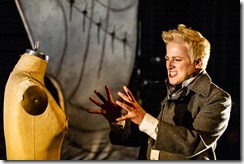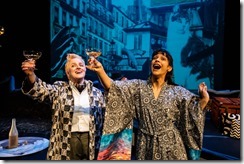Heartlines: an engaging new drama that opens the world for women artists in Europe.
by Alvina Ruprecht
 Margo MacDonald t
Margo MacDonald t Margo Macdonald and Maryse Fernandes
Margo Macdonald and Maryse Fernandes
Photos Andrew Alexander
Heartlines closes the spring season of 2022 in the Great Canadian Theatre Company in Ottawa. It is a memory play which foregrounds not only interesting theatrical representations of gender but also experiments in theatrical form itself as the author and the director draw examples from Cabaret, from visions of sets that displace the spectator through the streets of Paris suggesting the period of the 1920’s when the new modernist creativity was booming.
The protagonists are two famous lesbian lovers immersed in the artistic experiment of Surrealism. Lucy Schwab is better known as the photographer Claude Cahoun who assumed the identity of a man (played by Margo MaacDonald). She accompanies Suzanne (Maryse Frenandez) who designed daring new clothes and together, their visual experiments echoed by the light infused multilayered set immediately brings their world to life.
The play begins in the past , as the less emotionally explosive Suzanne opens the show by digging around in the dusty contents of an old trunk full of theatrical costumes hidden away in an attic space. As she pulls out these remnants of their past, a mysterious blond woman suddenly materializes, swimming across the back of the stage , following a narrow surface of water, defined by a long line of arms, legs and body parts, (suggesting the work of Hans Arp), indicating a watery game of chance introduced by the Surrealists – the Cadavre exquis- a new form of Surrealist poetry. Sentences are accumulated on a sheet of paper, with no attempt at any logical links . These are the leftovers of a dismantled collage that some giddy Dada enthusiast might have imagined.
Rapidly the lights change, as lighting designer Tristan-Oivier Breiding’s magical effects, capture the shift in time-line bringing us into the pre-war period of their adventure. The two girls decide to go to school in Nantes and live out their lives together as a couple.
Lucy Schwob, is clearly the more theatrical character of the two – feisty, anxious to get on with her sexual discovery and take on the physical and social challenges of their relationship. Each one complements the needs of the other and they turn into the perfect performing duo.
Canadian playwright Sarah Waisvisz then inserts her lovers into the world of great literature by suggesting that the passionate 12th century love story of Héloise and Abelard. is similar to the one we are witnessing on the stage. Waisvitz uses this poetic reference to help us grasp the special relationship between the two friends who are not a traditional couple but who have dared to set forth their own values on stage. In fact the author uses the poet’s language to bring into focus the world of the palm reader, a world of “luminous intensity”, that “third gender” , a non binary relationship that has emerged within the very personal reality of these two special women.
Waisvisz suggests how the surrealist movement , because of its daring social and political theories, produced anger among bourgeois audiences , whose presence is perfectly illustsrated by Vanessa Imeson’s period costumes and Andrea Steinwand’s sets. The whole theatre was transported into the middle of this jolting new world in a breathtaking way. Both Surrealism and Dada rejected hitherto accepted norms of art , of moral and social behaviour and these two women’s behaviour scandalized French society.
The first part of the show is a series of realistic dialogues as well as a series of Cabaret sketches reproducing images they inherited from their artist colleagues whom they met in Paris and who made a strong impression on these young women. The Icons of well-know works of art come floating around the video screen : the pulpy lips of Dali paintings, the figures of de Chirico, the photographic art of Man Ray and many others.
Quickly the playful Cabaret tone among all these influences become tragic as WWII is declared and the two friends realize how dangerous it is for them to stay in Mainland France as lesbians and even moreso because Luci is Jewish. Thus they leave Paris for the Channel Islands.
At that moment the parody becomes a lot more subversive.
The musical performance by sound designer Scottie Irving was particularly moving as he caresses the piano keys, producing sad tones which capture the disturbing internal struggle of each of these women. Irving contributed much to the sensitive work of director Rebecca Benson, whose remarkable choices maintained an emotional distance from the moments brutality , especially when Claude Cahoun is arrested and tortured by the gestapo. The beating mimed by the actor, removed all sense of reality and thrust us straight into the domaine of pure performance.
Despite the seriousness of the subject matter, the whole team produced a most enthralling and sparkling performance worthy at times of a Mel Brooks musical (The Producers) especially in the second act where movement, mimicry à la Charles Chaplin, prevailed.
As soon as the occupying german forces arrived in France, we were confronted by the biting humour and brilliant satire of these great comedians. We saw the German goose-stepping soldiers, with their purposely hysterical mimicry, their hysterical screetching voicses. As well as campy red and black swastikas fluttering in front of the soldiers, a clear reference to the “Freedom convoy” that hit Ottawa recently. Veiled references to the politics of fascism raised its ugly head on stage. The timing could not have been better.
Solid acting techniques backed up by Brechtian theories of epic theatre( to destroy the illusion of reality but which was itself satirized) brought this to life as a tribute to theatre itself, ta great weapon of subversion.
The essential theatricality of this daring performance avoided the trap of realism which might have transformed us into voyeurs ,but this was not the case. What we saw was a staging that maintained a healthy distance between what the production company said what was happening and what it hoped the audience could imagine, something honest, profound, artificially coherent . A feat of artistic magic that evoked all levels of this difficult experience and made it work beautifully!